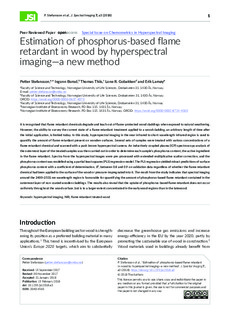| dc.contributor.author | Stefansson, Petter | |
| dc.contributor.author | Burud, Ingunn | |
| dc.contributor.author | Thiis, Thomas Kringlebotn | |
| dc.contributor.author | Gobakken, Lone | |
| dc.contributor.author | Larnøy, Erik | |
| dc.date.accessioned | 2018-09-21T09:09:27Z | |
| dc.date.available | 2018-09-21T09:09:27Z | |
| dc.date.created | 2018-07-09T15:12:07Z | |
| dc.date.issued | 2018-02-15 | |
| dc.identifier.citation | Journal of Spectral Imaging. 2018, 7 . | nb_NO |
| dc.identifier.issn | 2040-4565 | |
| dc.identifier.uri | http://hdl.handle.net/11250/2563851 | |
| dc.description.abstract | It is recognised that flame retardant chemicals degrade and leach out of flame-protected wood claddings when exposed to natural weathering. However, the ability to survey the current state of a flame retardant treatment applied to a wood cladding, an arbitrary length of time after the initial application, is limited today. In this study, hyperspectral imaging in the near infrared to short-wavelength infrared region is used to quantify the amount of flame retardant present on wooden surfaces. Several sets of samples were treated with various concentrations of a flame retardant chemical and scanned with a push broom hyperspectral camera. An inductively coupled plasma (ICP) spectroscopy analysis of the outermost layer of the treated samples was then carried out in order to determine each sample’s phosphorus content, the active ingredient in the flame retardant. Spectra from the hyperspectral images were pre-processed with extended multiplicative scatter correction, and the phosphorus content was modelled using a partial least squares (PLS) regression model. The PLS regression yielded robust predictions of surface phosphorus content with a coefficient of determination, R2, between 0.8 and 0.9 on validation data regardless of whether the flame retardant chemical had been applied to the surface of the wood or pressure-impregnated into it. The result from the study indicates that spectral imaging around the 2400–2531nm wavelength region is favourable for quantifying the amount of phosphorus-based flame retardant contained in the outermost layer of non-coated wooden claddings. The results also reveal that the uptake of phosphorus-based flame retardant does not occur uniformly throughout the wood surface, but is to a larger extent concentrated in the earlywood regions than in the latewood. | nb_NO |
| dc.language.iso | eng | nb_NO |
| dc.rights | Attribution-NonCommercial-NoDerivatives 4.0 Internasjonal | * |
| dc.rights.uri | http://creativecommons.org/licenses/by-nc-nd/4.0/deed.no | * |
| dc.subject | Hyperspectral imaging | nb_NO |
| dc.subject | NIR | nb_NO |
| dc.subject | Flame retardant wood | nb_NO |
| dc.title | Estimation of phosphorus-based flame retardant in wood by hyperspectral imaging—a new method | nb_NO |
| dc.type | Journal article | nb_NO |
| dc.type | Peer reviewed | nb_NO |
| dc.description.version | publishedVersion | nb_NO |
| dc.rights.holder | © 2018 The Authors | nb_NO |
| dc.subject.nsi | VDP::Teknologi: 500::Materialteknologi: 520::Bygningsmaterialer: 525 | nb_NO |
| dc.source.pagenumber | 9 | nb_NO |
| dc.source.volume | 7 | nb_NO |
| dc.source.journal | Journal of Spectral Imaging | nb_NO |
| dc.identifier.doi | 10.1255/jsi.2018.a3 | |
| dc.identifier.cristin | 1596404 | |
| dc.relation.project | Norges forskningsråd: 225345 | nb_NO |
| cristin.ispublished | true | |
| cristin.fulltext | original | |
| cristin.qualitycode | 1 | |

